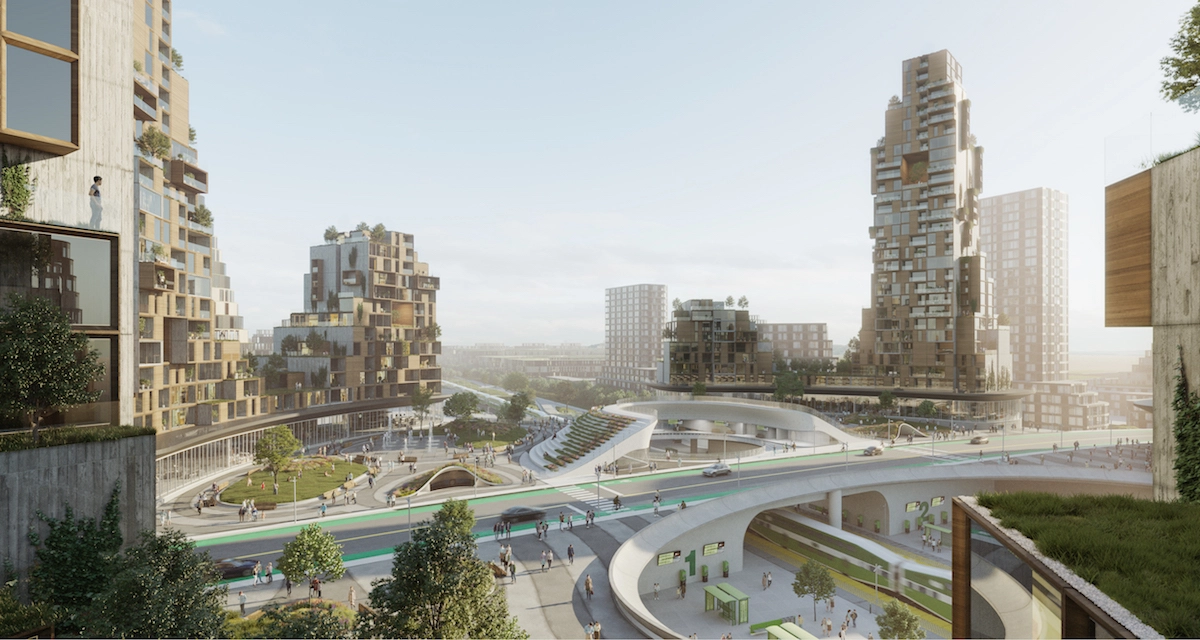With growing climate change awareness the worldwide market now sees sustainability as a dominant selling factor across multiple industries. The architecture and construction industries also show clear signs of this ongoing trend. If you stroll through any major city you will notice signs that advertise eco-friendly office spaces and net-zero apartment buildings as well as developments that claim to be sustainable. But behind these optimistic claims lies an important question: The challenge lies in determining which aspects represent true sustainability while others serve as deceptive greenwashing.
My experience as a sustainability-focused architect has revealed this phenomenon to expand amid feelings of both hope and scepticism. Genuine sustainable architecture exists but many projects use sustainable language and aesthetics which fail to provide real environmental benefits. The deceptive practice known as “greenwashing” can cause misinformation among clients, consumers, and policymakers while jeopardizing real responsible building initiatives. Today we will explore greenwashing in architecture by looking at its underlying mechanisms while discussing its significance and how to enforce real sustainability within the field.
Understanding Greenwashing in Architecture
Greenwashing describes deceptive assertions regarding the environmental credentials of buildings, projects, or products. This form of greenwashing creates an illusion of environmental responsibility by integrating minimal sustainable features into marketing strategies.
Architectural greenwashing shows up through multiple approaches.
Superficial Additions
The most prevalent type involves buildings displaying minimal sustainable features like solar panels, green roofs, or landscaping which create a false impression of environmental commitment while neglecting fundamental sustainability issues such as energy efficiency and sustainable material sourcing.
A large commercial building that uses only a few solar panels and a small green wall might brand itself as sustainable. When a building continues to depend extensively on fossil fuels and features inadequate insulation or unsustainable construction materials the green elements function mainly as decorative features rather than effective answers.
Misleading Certifications
Another issue arises with certification systems. Developers sometimes take advantage of the valuable assessment tools provided by standards such as BREEAM and LEED. Developers can achieve certification through superficial sustainability measures like bicycle racks and low-flow taps without tackling fundamental sustainability concerns such as long-term energy performance and building-related transport emissions.
Lack of Transparency
The absence of transparency creates a fertile ground for greenwashing tactics to succeed. Organizations market their use of sustainable materials and renewable energy sources but often withhold complete supply chain details and actual building performance data after construction. A lack of transparent data leaves architects, clients, and the public unable to properly evaluate sustainability claims which allows room for exaggeration and deceptive practices.
Why Greenwashing is a Problem
So, why is greenwashing in architecture problematic?
‘Better to have limited action than no action at all.’
Erosion of Trust
Firstly, greenwashing undermines trust. The practice of overstating environmental achievements by architects or construction firms leads to widespread public doubt about all sustainability initiatives. Long-term trust along with transparency and stakeholder cooperation forms the foundation of genuine sustainability. Erosion of trust makes it more difficult for legitimate sustainability initiatives to achieve traction.
Missed Opportunities for Genuine Sustainability
Greenwashing misdirects both attention and resources which should instead be allocated to meaningful sustainability actions. Clients, investors, and local authorities who think superficial solutions are adequate will likely avoid demanding deeper sustainability changes like comprehensive energy efficiency improvements, sustainable material sourcing, or carbon-negative design solutions. This situation creates a risk where valuable chances to achieve meaningful environmental improvements will be missed.
Delayed Policy Progress
Finally, greenwashing can also undermine policy progress. Regulators who find construction industry self-regulation through basic green initiatives will have little motivation to develop stringent policies that require authentic sustainability practices. The current system rewards inadequate efforts which blocks progress towards achieving authentic sustainable construction practices.
Distinguishing Genuine Sustainability
How can we differentiate real sustainable architecture from deceptive green practices? Real sustainability is comprehensive, transparent, and measurable. Here are some crucial factors to consider:
Holistic Design
Genuine sustainable architecture evaluates buildings comprehensively by considering construction materials and energy performance along with occupant health and lifespan as well as adaptability and future reuse or recycling. True sustainable buildings require comprehensive design thinking instead of just superficial environmental features because they must meet future environmental and social requirements.
Lifecycle Analysis and Embodied Carbon
The full lifecycle of sustainable buildings includes embodied carbon which reflects the emissions from material extraction and processing to transportation and disposal. Sustainability-focused architects make deliberate choices to use low-carbon and renewable materials while minimizing waste and creating adaptable and durable designs.
Measurable Results and Post-Occupancy Evaluations
Authentic sustainable projects maintain transparency with their performance data. Through continuous monitoring and post-occupancy evaluations buildings’ performance can be verified to ensure they meet their intended functions. True sustainability requires organisations to maintain accountability while sharing energy data and continuously improving their practices. The majority of greenwashed projects fail to participate in open evaluation processes.
Holding Architecture Accountable: Practical Solutions
With the problem of greenwashing in architecture now clearly identified what are the steps we can take to correct this issue and enforce accountability within the industry?
Rigorous Certification and Auditing
Standards for certification must undergo constant evolution to eliminate loopholes and focus more on substantial metrics including embodied carbon and energy use intensity alongside occupant wellbeing and durability of sustainability. It is crucial to conduct post-occupancy audits of buildings to measure their actual performance against their predicted performance.
Transparency and Mandatory Disclosure
Requiring building energy performance data, embodied carbon metrics and complete supply-chain details will substantially cut down greenwashing activities. There needs to be a commitment from architects, clients, and developers to share these details openly. When transparency becomes a standard practice it will become more difficult to make exaggerated claims.
Educating Clients and the Public
Architects must perform dual roles by designing sustainable buildings and teaching their clients and communities about authentic sustainability. When clients understand sustainable practices they will expect better standards which discourages developers and architects from greenwashing.
Stronger Regulatory Frameworks
The responsibility of governments and local authorities must include the creation of strict regulatory systems which recognize true sustainable practices while penalizing false sustainability claims. Government-led incentives including tax reductions and accelerated planning permission could drive substantial progress towards authentic sustainability in building projects.
The Architect’s Ethical Responsibility
Some sustainable architects uphold their ethical duty to resist deceptive greenwashing practices. The field of architecture stands in a prime position to make impactful contributions toward sustainable design practices. It is vital that we support authentic sustainable practices while exposing false solutions and maintain mutual responsibility among ourselves. There are moments when architects need to deliver difficult truths to clients and resist market pressures that lack foresight.
Architects who prioritize sustainable practices need to make transparency and honesty fundamental aspects of their professional work. Architects who promote authentic sustainability while rejecting greenwashing practices contribute to creating a more robust and environmentally aware industry that people can trust.
Conclusion: A Call for Integrity
The deceptive practice of greenwashing presents serious risks to the advancement of sustainable architecture. Superficial eco-friendly claims may provide immediate market benefits but ultimately damage trust, postpone necessary environmental measures and weaken our fight against climate change.
Architects together with the construction sector possess the ability to transform this narrative. Through our commitment to sustainable practices that are holistic and measurable while maintaining transparency we can prove authentic leadership in overcoming environmental problems.
Architects need to take action through transparent commitment to sustainability principles while building environmentally friendly structures. Our profession demands this level of integrity for both our clients and our planet.






